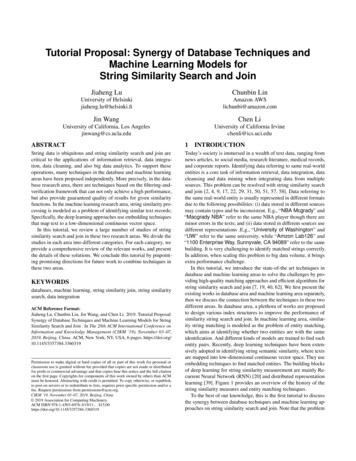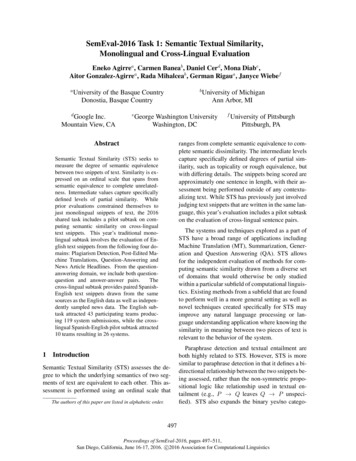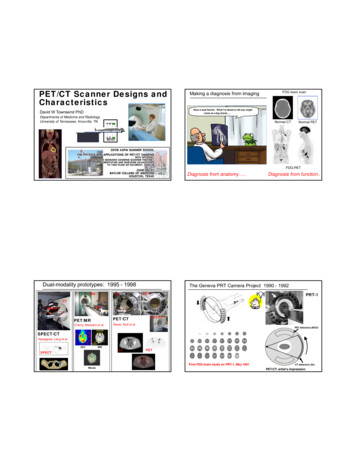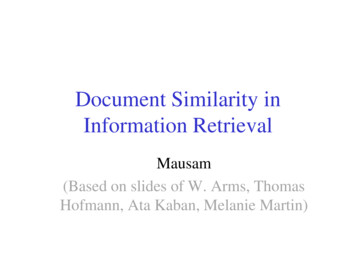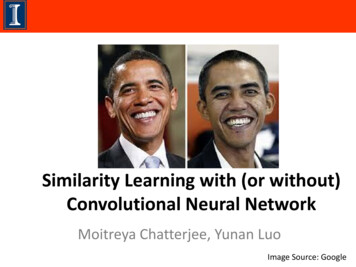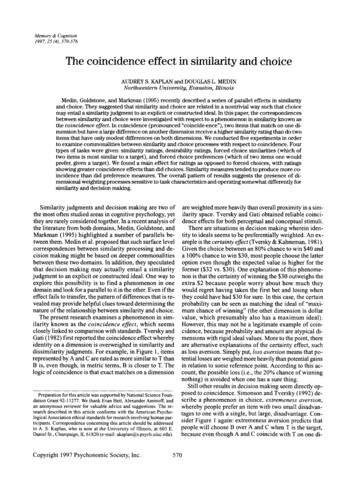
Transcription
Memory & Cognition1997,25 (4),570-576The coincidence effect in similarity and choiceAUDREY S, KAPLAN and DOUGLAS L, MEDINNorthwestern University, Evanston, IllinoisMedin, Goldstone, and Markman (1995) recently described a series of parallel effects in similarityand choice. They suggested that similarity and choice are related in a nontrivial way such that choicemay entail a similarity judgment to an explicit or constructed ideal. In this paper, the correspondencesbetween similarity and choice were investigated with respect to a phenomenon in similarity known asthe coincidence effect. In coincidence (pronounced "coincide-ence"), two items that match on one dimension but have a large difference on another dimension receive a higher similarity rating than do twoitems that have only modest differences on both dimensions. We conducted five experiments in orderto examine commonalities between similarity and choice processes with respect to coincidence. Fourtypes of tasks were given: similarity ratings, desirability ratings, forced choice similarities (which oftwo items is most similar to a target), and forced choice preferences (which of two items one wouldprefer, given a target). We found a main effect for ratings as opposed to forced choices, with ratingsshowing greater coincidence effects than did choices. Similarity measures tended to produce more coincidence than did preference measures. The overall pattern of results suggests the presence of dimensional weighting processes sensitive to task characteristics and operating somewhat differently forsimilarity and decision making.Similarity judgments and decision making are two of are weighted more heavily than overall proximity in a simthe most often studied areas in cognitive psychology, yet ilarity space. Tversky and Gati obtained reliable coincithey are rarely considered together. In a recent analysis of dence effects for both perceptual and conceptual stimuli.There are situations in decision making wherein identhe literature from both domains, Medin, Goldstone, andMarkman (1995) highlighted a number of parallels be- tity to ideals seems to be preferentially weighted. An extween them. Medin et al. proposed that such surface level ample is the certainty effect (Tversky & Kahneman, 1981).correspondences between similarity processing and de- Given the choice between an 80% chance to win 40 andcision making might be based on deeper commonalities a 100% chance to win 30, most people choose the latterbetween these two domains. In addition, they speculated option even though the expected value is higher for thethat decision making may actually entail a similarity former ( 32 vs. 30). One explanation of this phenomejudgment to an explicit or constructed ideal. One way to non is that the certainty of winning the 30 outweighs theexplore this possibility is to find a phenomenon in one extra 2 because people worry about how much theydomain and look for a parallel to it in the other. Even ifthe would regret having taken the first bet and losing wheneffect fails to transfer, the pattern of differences that is re- they could have had 30 for sure. In this case, the certainvealed may provide helpful clues toward determining the probability can be seen as matching the ideal of "maxinature of the relationship between similarity and choice. mum chance of winning" (the other dimension is dollarThe present research examines a phenomenon in sim- value, which presumably also has a maximum ideal).ilarity known as the coincidence effect, which seems However, this may not be a legitimate example of coinclosely linked to comparison with standards. Tversky and cidence, because probability and amount are atypical diGati (1982) first reported the coincidence effect whereby mensions with rigid ideal values. More to the point, thereidentity on a dimension is overweighed in similarity and are alternative explanations of the certainty effect, suchdissimilarity judgments. For example, in Figure 1, items as loss aversion. Simply put, loss aversion means that porepresented by A and C are rated as more similar to T than tentiallosses are weighed more heavily than potential gainsB is, even though, in metric terms, B is closer to T. The in relation to some reference point. According to this aclogic of coincidence is that exact matches on a dimension count, the possible loss (i.e., the 20% chance of winningnothing) is avoided when one has a sure thing.Still other results in decision making seem directly opposed to coincidence. Simonson and Tversky (1992) dePreparation for this article was supported by National Science Founscribe a phenomenon in choice, extremeness aversion,dation Grant 92-11277. We thank Evan Heit, Alexander Aminoff, andan anonymous reviewer for valuable advice and suggestions. The rewhereby people prefer an item with two small disadvansearch described in this article conforms with the American Psychotages to one with a single, but large, disadvantage. Conlogical Association ethical standards for research involving human parsider Figure 1 again: extremeness aversion predicts thatticipants. Correspondence concerning this article should be addressedpeople will choose B over A and C when T is the target,to A. S. Kaplan, who is now at the University of Illinois, at 603 E.Daniel St., Champaign, IL 61820 (e-mail: akaplan@s.psych.uiuc.edu).because even though A and C coincide with T on one di-Copyright 1997 Psychonomic Society, Inc.570
SIMILARITY. CHOICE, AND COINCIDENCETABcFigure 1. The coincidence effect says that A and C will be ratedas more similar to T than B because they match T on one dimension each while B does not match T on either dimension. In metric terms, B is closer to T.mension, they differ greatly on the other dimension. Option B can be seen as a compromise between A and C.However, when one is rating similarity, the coincidenceeffect shows that A and C are considered more similar toT than is B. This pair of results seems troubling for thehypothesis that choice and similarity involve similar processes. How can similarity and choice share commonprocesses if they give rise to incompatible effects? Onepossibility is that there are different kinds of, or respectsfor, similarity (Medin, Goldstone, & Gentner, 1993).Thus, some conditions may lend themselves to coincidence, whereas others favor anticoincidence (as in extremeness aversion). In particular, similarity and choicewere measured differently in the examples above; similarity was rated on a numerical scale and the choiceswere binary preferences. It is unclear what would happenif we asked people to rate their preferences numericallyor make similarity judgments as forced choices.Choice is known to embody flexibility, as has beenwell witnessed by context effects. For example, preference reversals occur when different ways of assessingpreferences yield different results. Slovic and Lichtenstein (1968) reported that people would rather playagamble with a high probability of winning, but that theywould pay more to play, or ask a higher selling price for,a gamble with a larger payoff. Here the dimensions ofpayoff and probability are weighted differently, depending on the context.The experiments in this paper were performed in anattempt to unconfound similarity from ratings and preference from forced choice. By so doing, we hoped to discover whether there are conditions under which similarity and choice yield the same results, or whether they aresystematically different. In the first two experiments, wewere concerned with ratings; in the first, participantsmade similarity ratings, and in the second, participantsmade desirability ratings. In the third and fourth experiments, we employed a forced choice task in which participants had to choose which of two options was moresimilar to a target (Experiment 3) or which option theywould prefer, relative to the same target (Experiment 4).Finally, in the fifth experiment we examined the effects571of explicit dimensional weighting strategies (or lackthereof) on the coincidence effect.To our knowledge, no one has either replicated the coincidence effect or related it to forced choice. The goalof the present study was to determine the range of contexts in which the coincidence effect would appear. Specifically, we were interested in two factors of the task. First,is the coincidence effect dependent on ratings of similarity, or would desirability (preference) ratings show acoincidence pattern as well? Second, do people ever employ a coincidence strategy in forced choices? Theforced choice results of Simonson and Tversky (1992)suggest that they do not. Their choices were preferences,however, and it is not clear how coincidence would fareifpeople were asked to choose which oftwo options weremost similar to a target. In Experiments 3 and 4, similarity forced choices were contrasted with preference forcedchoices. Thus, there were two kinds of judgments to bemade, similarity and preference, and two modes of responding, ratings or forced choices. The experiments thatfollow addressed each of these situations in turn.EXPERIMENTS 1-2Similarity and Desirability RatingsTversky and Gati (1982) originally discovered the coincidence effect by using perceptual stimuli, but theyalso obtained the effect with conceptual materials. Theirconceptual stimuli were descriptions of students on twodimensions: academic major (ordered from technical tohumanistic) and political affiliation (ordered from conservative to liberal). The conceptual stimuli used in our'experiments were brief descriptions of dogs, containinginformation only on their size and temperament levels.The sizes used were very large, large, medium, and small;the temperament levels were sociable to any person,friendly, tolerant, and somewhat tolerant. The purpose ofExperiment 1 was to replicate the findings ofTversky andGati. Here, we asked participants to rate the similarity ofall possible pairs of different dogs. In Experiment 2, participants were asked to rate the desiribility of an availabledog given an ideal dog. The ideal and available dog pairswere exactly those used in Experiment 1. We expected tofind a coincidence effect in Experiment I, but it was unclear whether desirability ratings would also exhibit acoincidence effect. Given the loss aversion results discussed above, it may be that preferences do not exhibitcoincidence.MethodSubjects. Twenty-six college age people residing in the Chicagometropolitan area participated in each study. In all the experimentsreported in this paper, nobody participated in more than one study.Participation was solicited by advertisements on the NorthwesternUniversity campus. Participants were paid for their cooperation.Materials. The stimuli for all experiments consisted of brief descriptions of dogs characterized on two dimensions: size and temperament. Four levels of each dimension were specified. The sizeswere. in increasing order: small, medium. large, and very large. Thetemperament levels were. in increasing ferocity: sociable to any
572KAPLAN AND MEDINperson, friendly, tolerant, and somewhat tolerant. Figure 2 showsthe 16 different dog descriptions generated by pairing each sizewith each temperament.Procedure. All experiments were run on a computer with a 23.5X 17.5 em display screen. In Experiment 1, participants were toldthat they would see a series of dog descriptions, based on size andtemperament, two at a time. Their task was to rate the similarity ofthe two dogs on a scale of 1-9, with 1 corresponding to the lowestsimilarity rating and 9 to the highest. Participants were told aboutall of the possible sizes and temperaments in the instructions inorder to ensure that they took into consideration the combinationsthey were likely to see later when making their early judgments. All120 possible dog description pairs were presented. The experimentlasted approximately 20 min.The dog descriptions were written in boxes (6.8 X 2.8 ern) displayed on the screen 0.5 cm apart. The size was written on the firstline, and the temperament was written directly below it. Buttonsranging from 1 to 9 were placed under the descriptions with thewords "low sim," under the low end of the scale and "high sim,"under the high end of the scale. Participants clicked on the ratingbuttons to indicate the similarities. The order of dog descriptionpresentations was randomized. Participants were self-paced andwere debriefed at the end of the experiment.In Experiment 2, participants read the following instructions.In this experiment we would like you to pretend that you are the ownerof a pet store that sells various types of dogs. Customers will come inand describe to you the size and temperament characteristics of theirideal dog choices. You will see a series of dog descriptions, two at atime. One will be the customer's ideal and the other will be a dog thatyou have available for sale. Each dog will be described by a size: small,medium, large, or very large, and a temperament: sociable to any person, friendly, tolerant, or somewhat tolerant. For each pair, we wouldlike you to rate the desirability of the available dog given the ideal dogon a nine point scale where one is low desirability and nine is highdesirability.To ensure that each dog appeared an equal number of times as theideal and available dog, participants did each desirability ratingtwice, once with the ideal on the left and the available on the right,and once vice versa. Thus, each participant produced 240 desirability ratings. The experiment lasted approximately 40 min. Participants were debriefed at the end of the experiment.Results and DiscussionThe data were analyzed in two different ways. Following Tversky and Gati (1982), we analyzed all quadruplesVery largeLargeabedghkMediumSmallcmSociable toany ntFigure 2. Stimuli for the experiments. Each lowercase letterrepresents a dog description (i.e., a very large, sociable to anyperson).forming the three corners of a right triangle plus a pointon the hypotenuse (see Figure 3). The triangle inequality states that the sum of any two sides of a triangle mustbe greater than the third side. Since similarity is inverselyproportional to distance (i.e., two things rated highly similar are very close in a similarity space), one can see thatthe triangle inequality is satisfied whensim(j,b) :'5: sim(b,g) and sim(j,l) :'5: sim(g,l)orsim(j,b) :'5: sim(g,l) and sim(j,l) :'5: sim(b,g).The triangle inequality is violated when the opposite pattern of inequalities holds. Another way of stating the triangle inequality is to say that the corner path from b to I(going through j) must be greater than the center path fromb to I (going through g). Coincidence can be thought ofas a violation ofthe triangle inequality, because if dimensional matches are overweighed in similarity judgments,the legs of the triangle become shorter, diminishing thecorner path.There were 24 appropriate triangles in our stimulusset: 4 from each of the four 3 X 3 subsquares plus 2 fromeach of the four extreme corners. The hypotenuse stimulus on each of the extreme triangles was always one ofthe two points along the diagonal of that triangle. For example, when a was the corner, the diagonals were d, g, mand d.], m, where g andj were the hypotenuse stimuli.Thus, each extreme corner right angle was used in twotriangles, one with each of the hypotenuse stimuli as thecenter.For each participant, we counted Co, the number oftriangles for which the corner path was greater than thecenter path (confirming the triangle inequality), and Ce,the number of triangles for which the center path wasgreater than the corner path (indicating coincidence).Participants were then grouped into the following fivecategories: (I) Co » Ce (double inequality sign indicatessignificance by sign test at the .05 level); (2) Co Ce;(3) Co Ce; (4) Co Ce; and (5) Co« CeoWe also analyzed the data using an ideal-based method.Each right-angle corner stimulus can be thought of as anideal. For example, in Figure 3, where the ideal isj, wecompared sim(j,b) with sim(j,g) and sim(j,l) withsim(j,g). If the similarity ofthe ideal to a coinciding dogis greater than the similarity ofthe ideal to the hypotenusedog, we have a case of coincidence. The opposite relationis an example of anticoincidence. For each participant wecounted A, the number of incidents of anticoincidence,and C, the number of coincidence occurrences. In thisanalysis, there were 48 comparisons instead of24, becauseeach ideal is compared with the coinciding alternative oneach dimension separately. Participants were then groupedinto the following five categories: (1) A» C (double inequality sign indicates significance by sign test at the .05level); (2) A C; (3) A C; (4) A C; and (5) A «c.Note that A is analogous to Co and C is analogous to Cein that they are measures of a participant's tendency toward anticoincidence and coincidence, respectively. Thus,
SIMILARITY, CHOICE, AND COINCIDENCEb-.-.--------1Figure 3. An example of a triangle used to test the triangle inequality and ideal-based coincidence.we should find roughly equivalent numbers of participantsin corresponding categories across these two classification systems.We used the triangle inequality method because this ishow Tversky and Gati (1982) analyzed their results andwe wanted to be able to compare our results with theirs.The ideal-based method was used because it allowed usto directly test the hypothesis that forced choices are basedon similarity to an ideal. For example, in Figure 3, ifsim(j,b) were greater than sim(j,g), we might expect thatb would be chosen over g when} was the ideal.Table I contains the results from all five experiments.The results of both methods of analysis show that coincidence was the dominant strategy employed by our participants in Experiment I. In both cases, 23 out of26 participants showed a coincidence pattern more often thananticoincidence, and no participants were in the statistically significant anticoincidence groups. If for eachmethod ofanalysis we collapse the two groups above theequality relation (Co» Ce and Co Ce for the triangleinequality method and A » C and A C for the idealbased method), we derive two groups corresponding tooverall anticoincidence. Doing the same for groups belowthe equality relation gives us two overall coincidencegroups. This redistributes our participants into two categories, overall coincidence (OC) or overall anticoincidence (OA).Having done this, we compared the number of participants in the OC and OA groups. Within each methodof analysis, a statistically reliable coincidence effectwas found in Experiment I. For the triangle inequalitymethod, X2 (I, N 26) 15.38, P .01. For the idealbased method, X2 (I, N 25) 17.64,p .01. We wentback to Tversky and Gati's (1982) triangle inequality studyon students and reorganized their data in this fashion andfound X2 (1, N 29) 3.90, P .05 in favor of coincidence. In short, we replicated Tversky and Gati's coincidence effect.The results from Experiment 2 were more ambiguous.The participants in this experiment failed to show predominantly coincidence or anticoincidence, as evidencedby the OA and OC groupings for the triangle inequalitymethod (13 and 13) and the ideal-based method (10 and15, respectively). About half of the participants favoreda coincidence pattern, and about half favored an antico-573incidence pattern. A chi-square test on the OA and OCgroups between Experiments 1 and 2 showed that the coincidence effect is reliably larger in Experiment I [X 2 (I,N 50) 7.02,p .01].Finally, for each participant we computed the proportion coincidence (PC) according to the formula PC Ce /(Co Ce) for the triangle inequality method and PC C / (A C) for the ideal-based method. The mean PCsfor Experiment I (mean PC .76, SD .18 for the triangle inequality method, and mean PC .69, SD .16 forthe ideal-based method) were higher than those for Experiment 2 (mean PC .51, SD .28 for the triangleinequality method, and mean PC .51, SD .14 for theideal-based method). The ideal-based PC values are significantly different from.5 only in Experiment 1 [t(25) 7.22,p .001 for the triangle inequality, and t(25) 5.94,p .001 for the ideal-based], again indicating coincidence.Overall then, the similarity ratings reveal a robust coincidence effect, whereas the desirability ratings of exactly the same pairs do not. On the other hand, the desirability ratings also do not show the anticoincidence patternnoted by Simonson and Tversky (1992). One interpretation of the difference between similarity and desirabilityrating results is that the desirability task strongly encourages an equal weighting of dimensions. If so, one shouldbe able to reduce or eliminate the coincidence effectin similarity judgments by instructions aimed at discouraging selective weighting of dimensions. Experiment 5 examines this possibility. First, however, we turnour attention to forced choice measures of similarity andpreference.EXPERIMENTS 3-4Forced Choice Similarity and PreferenceImagine a forced choice situation in which one is presented with a target dog-say, "Very large, Tolerant"above two option dogs-say, "Very large, Sociable to anyperson" and "Large, Friendly." In the following two exTable 1Grouping of Participants in all ExperimentsExperimentCategory23Co» CeCo CeCo CeCo CeCo «Ce030716Triangle Inequality58094A»CA CA CA 106Note---Co, number of triangles for which the corner path was greaterthan the center path; Ce, number of triangles for which the center pathwas greater than the corner path; A, number of incidents of anticoincidence; C, number of incidents of coincidence.
574KAPLAN AND MEDINperiments, we presented participants with such triads options were hand k on one trial and k and n on another. Thus forand asked them to choose which of two option dogs was each 3 X 3 subsquare, two pairs of options were presented (on sepmost similar to the target dog (Experiment 3) or which of arate trials). Notice that k differs from f on two dimensions, whereasthe same two option dogs they would prefer, given the hand n coincide with f on size and temperament, respectively. Inthis way, the participant was always choosing between the coincidtarget dog as an ideal (Experiment 4). Both ofthese tasks ing and anticoinciding dogs (Experiment 4) or choosing the moreinvolve forced choices; the difference is that Experi- similar of a coinciding and anticoinciding dog to the target (Experment 3 was a similarity forced choice and Experiment 4 iment 3). For each 4 X 4 target, two diagonals were used, consistwas a preference forced choice. Thus, Experiments 3 and ing ofthe two coinciding extremes with one ofthe two intermediates4 were forced choice analogues of Experiments 1 and 2, along the diagonal (e.g., target a with m.j, and d, and with m, g, andd). Thus for each 4 X 4 target, four pairs of options were presentedrespectively.(on separate trials). The triads were shown in random order. Both exIf people use a coincidence strategy, we would expect periments lasted about 15 min. Participants were self-paced andthem to choose the dog that is "Very large, Sociable to were debriefed at the end of the experiment.any person" over the dog that is "Large, Friendly," because the target and the first option match on the size di- Results and Discussionmension. The other dog would be picked more often inSince in each trial of these two experiments the parthis triad if people used an anticoincidence strategy. We ticipant chose either the coinciding or the anticoincidingpredicted that people would show anticoincidence in the dog, we counted A and C directly. The results from Experpreference task (Experiment 4), because it seems in line iment 3 showed a modest but reliable tendency toward anwith the Simonson and Tversky (1992) results on ex- anticoincidence pattern. Out of26 participants, 17 showedtremeness aversion. However, it was unclear what to ex- an anticoincidence pattern more often than not, and 7pect when we asked people to choose one of the dogs as showed a coincidence pattern a majority of the time. Thisbeing most similar to the target (Experiment 3). If the result is statistically significant Lx 2 (1, N 24) 4.16,coincidence effect is not sensitive to response mode (i.e., p .05]. The mean PC value (.45,SD .15), while notreratings vs. forced choices), we would expect results sim- liable, is also in the direction of anticoincidence.ilar to those of Experiment 1. If a strong coincidence patIn Experiment 4, 25 out of 26 participants showed antern is dependent on numerical ratings, we would expect anticoincidence pattern rather than coincidence, 19 ofthe opposite pattern of results.them significantly more often. This anticoincidence effect was highly significant when we compared the overMethodall anticoincidence and overall coincidence collapsedSubjects. Twenty-six Northwestern University undergraduatesgroups [X 2 (1, N 26) 11.08, P .01]. The mean PCparticipated in each experiment. Most participated to fulfill a classvalue for Experiment 4 was .25 (SD .15). This value isrequirement, but some were paid for their participation.significantly different from .5 [t(25) 8.33, P .001],Materials. The same dog descriptions that were used in the lastindicating anticoincidence. This result is compatible withexperiment were used as stimuli in this experiment.Procedure. The instructions for Experiment 3 read as follows:extremeness aversion.The combined results of Experiments 3 and 4 suggestYouwill see a series of dog descriptions three at a time. Each dog willbe described by a size and a temperament. The sizes are, in increasingthat anticoincidence is the dominant pattern in forcedorder: small,medium,large,and very large.The temperamentlevelsare,choice situations. However, if we compare the OA andin increasing ferocity: sociable to any person, friendly, tolerant, andOC groups across these two experiments, we find thatsomewhattolerant. In each case the dog at the top of the screen will bethe "Target Dog." Yourtask is to choose which of the two dogs underthe anticoincidence effect is larger in forced choice prefneath is more similar to the "Target Dog." Just click on the button unerences than in forced choice similarity [X 2 (I, N derneath the dog of your choice.50) 5.95,p .05]. Looking across Experiments 1 andThe instructions for Experiment 4 read as follows:2 in comparison with 3 and 4, one can see both a main effect oftask (ratings lead to more coincidence; choices, toIn this experimentwe would like you to pretend that you are the ownerof a pet store that sells various types of dogs. Customers will come inanticoincidence) and a main effect of similarity versusand describe to you the size and temperament characteristics of theirpreference(with similarity leading to larger coincidenceideal dog choices. Along with the customer's ideal, you will see twoeffects). We believe that both patterns can be accommodog choices (labeled A and B) that you have for sale. Each dog will bedescribed by a size and a temperament. The sizes are, in increasingdated within the framework offactors that promote or disorder: small, medium, large, and very large. The temperament levelscourage differential weighting of dimensions. In the finalare, in increasingferocity: sociable to any person,friendly, tolerant, andexperiment, we examined the role of selective attention insomewhattolerant. For each pair of availabledogs we would like you tosimilarity ratings. We hypothesized that we would see anrecommendone of the dogs to the customer based on their stated ideal.Just click on the corresponding button (A or B) underneath your doganticoincidence or a very weak coincidence effect if peorecommendation.ple were encouraged to pay attention to both dimensions.For each triad, the target (same as customer's ideal) was a cornerstimulus of a 3 X 3 subset of the stimuli in Figure 2 or a corner ofthe entire set (dogs a, d, m, and p). Thus, the targets corresponded tothe ideals from the ideal-based method of analysis. The option dogswere two of the three dogs forming the diagonal of a given subsetconsisting of the hypotenuse (anticoincidence) stimulus plus one ofthe coinciding dogs. For example, when dog f was the target, theEXPERIMENT 5In Experiment 5, participants were asked to pretendthat they were the owner of a pet store selling varioustypes of dogs described by the same size and tempera-
SIMILARITY, CHOICE, AND COINCIDENCEment levels as in the previous experiments. They weretold that they would see pairs of dog descriptions, one ofwhich was labeled as the customer's ideal and the otherlabeled as a dog available for sale. The task was to ratethe similarity of the available dog to the ideal dog on ascale of I to 9. Thus, this task can be seen as a hybrid ofExperiments I and 2. However, unlike in the earlier tasks,the instructions in this experiment stressed the importance of paying attention to both dimensions.MethodSubjects. Twenty-six college-age people residing in the Chicagometropolitan area participated in this study. Participation was solicited by advertisements on the Northwestern University campus.Participants were paid for their cooperation.Materials. The same dog descriptions used in the previous studies were used in this experiment as well.Procedure. In this experiment, participants were asked to pretend that they were the owner of a pet store selling various types ofdogs described by the same size and temperament levels as in thefirst two experiments. They were told that they would see pairs ofdog descriptions, one of which was labeled as the customer's idealand the other labeled as a dog available for sale. The labels werewritten underneath the boxes containing the dog descriptions. Thetask was to rate the similarit
AUDREY S, KAPLAN and DOUGLAS L, MEDIN Northwestern University, Evanston, Illinois Medin, Goldstone, and Markman (1995) recently described a series of parallel effects in similarity and choice. They suggestedthatsimilarity andchoice are related in a nontrivial way suchthatchoice . However, this may not be a legitimate example ofcoin .


